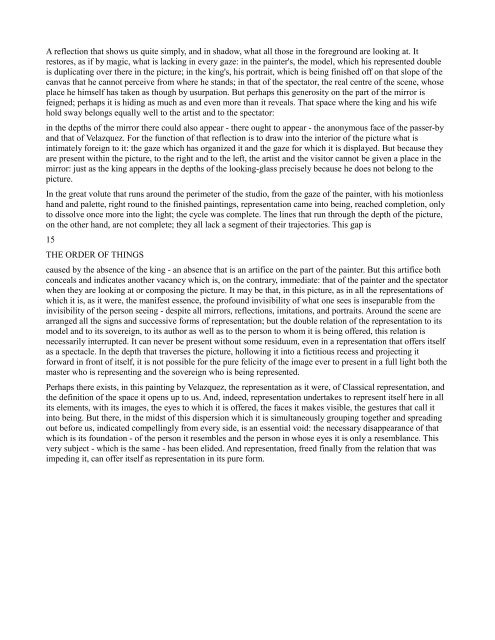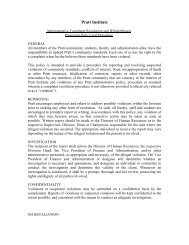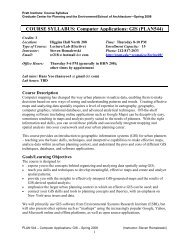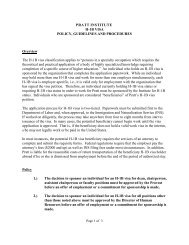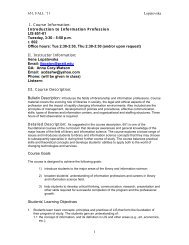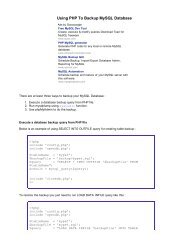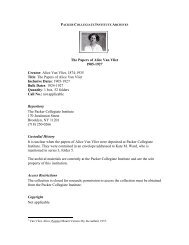Michel Foucault, THE ORDER OF THINGS An Archeology of the ...
Michel Foucault, THE ORDER OF THINGS An Archeology of the ...
Michel Foucault, THE ORDER OF THINGS An Archeology of the ...
Create successful ePaper yourself
Turn your PDF publications into a flip-book with our unique Google optimized e-Paper software.
A reflection that shows us quite simply, and in shadow, what all those in <strong>the</strong> foreground are looking at. It<br />
restores, as if by magic, what is lacking in every gaze: in <strong>the</strong> painter's, <strong>the</strong> model, which his represented double<br />
is duplicating over <strong>the</strong>re in <strong>the</strong> picture; in <strong>the</strong> king's, his portrait, which is being finished <strong>of</strong>f on that slope <strong>of</strong> <strong>the</strong><br />
canvas that he cannot perceive from where he stands; in that <strong>of</strong> <strong>the</strong> spectator, <strong>the</strong> real centre <strong>of</strong> <strong>the</strong> scene, whose<br />
place he himself has taken as though by usurpation. But perhaps this generosity on <strong>the</strong> part <strong>of</strong> <strong>the</strong> mirror is<br />
feigned; perhaps it is hiding as much as and even more than it reveals. That space where <strong>the</strong> king and his wife<br />
hold sway belongs equally well to <strong>the</strong> artist and to <strong>the</strong> spectator:<br />
in <strong>the</strong> depths <strong>of</strong> <strong>the</strong> mirror <strong>the</strong>re could also appear - <strong>the</strong>re ought to appear - <strong>the</strong> anonymous face <strong>of</strong> <strong>the</strong> passer-by<br />
and that <strong>of</strong> Velazquez. For <strong>the</strong> function <strong>of</strong> that reflection is to draw into <strong>the</strong> interior <strong>of</strong> <strong>the</strong> picture what is<br />
intimately foreign to it: <strong>the</strong> gaze which has organized it and <strong>the</strong> gaze for which it is displayed. But because <strong>the</strong>y<br />
are present within <strong>the</strong> picture, to <strong>the</strong> right and to <strong>the</strong> left, <strong>the</strong> artist and <strong>the</strong> visitor cannot be given a place in <strong>the</strong><br />
mirror: just as <strong>the</strong> king appears in <strong>the</strong> depths <strong>of</strong> <strong>the</strong> looking-glass precisely because he does not belong to <strong>the</strong><br />
picture.<br />
In <strong>the</strong> great volute that runs around <strong>the</strong> perimeter <strong>of</strong> <strong>the</strong> studio, from <strong>the</strong> gaze <strong>of</strong> <strong>the</strong> painter, with his motionless<br />
hand and palette, right round to <strong>the</strong> finished paintings, representation came into being, reached completion, only<br />
to dissolve once more into <strong>the</strong> light; <strong>the</strong> cycle was complete. The lines that run through <strong>the</strong> depth <strong>of</strong> <strong>the</strong> picture,<br />
on <strong>the</strong> o<strong>the</strong>r hand, are not complete; <strong>the</strong>y all lack a segment <strong>of</strong> <strong>the</strong>ir trajectories. This gap is<br />
15<br />
<strong>THE</strong> <strong>ORDER</strong> <strong>OF</strong> <strong>THINGS</strong><br />
caused by <strong>the</strong> absence <strong>of</strong> <strong>the</strong> king - an absence that is an artifice on <strong>the</strong> part <strong>of</strong> <strong>the</strong> painter. But this artifice both<br />
conceals and indicates ano<strong>the</strong>r vacancy which is, on <strong>the</strong> contrary, immediate: that <strong>of</strong> <strong>the</strong> painter and <strong>the</strong> spectator<br />
when <strong>the</strong>y are looking at or composing <strong>the</strong> picture. It may be that, in this picture, as in all <strong>the</strong> representations <strong>of</strong><br />
which it is, as it were, <strong>the</strong> manifest essence, <strong>the</strong> pr<strong>of</strong>ound invisibility <strong>of</strong> what one sees is inseparable from <strong>the</strong><br />
invisibility <strong>of</strong> <strong>the</strong> person seeing - despite all mirrors, reflections, imitations, and portraits. Around <strong>the</strong> scene are<br />
arranged all <strong>the</strong> signs and successive forms <strong>of</strong> representation; but <strong>the</strong> double relation <strong>of</strong> <strong>the</strong> representation to its<br />
model and to its sovereign, to its author as well as to <strong>the</strong> person to whom it is being <strong>of</strong>fered, this relation is<br />
necessarily interrupted. It can never be present without some residuum, even in a representation that <strong>of</strong>fers itself<br />
as a spectacle. In <strong>the</strong> depth that traverses <strong>the</strong> picture, hollowing it into a fictitious recess and projecting it<br />
forward in front <strong>of</strong> itself, it is not possible for <strong>the</strong> pure felicity <strong>of</strong> <strong>the</strong> image ever to present in a full light both <strong>the</strong><br />
master who is representing and <strong>the</strong> sovereign who is being represented.<br />
Perhaps <strong>the</strong>re exists, in this painting by Velazquez, <strong>the</strong> representation as it were, <strong>of</strong> Classical representation, and<br />
<strong>the</strong> definition <strong>of</strong> <strong>the</strong> space it opens up to us. <strong>An</strong>d, indeed, representation undertakes to represent itself here in all<br />
its elements, with its images, <strong>the</strong> eyes to which it is <strong>of</strong>fered, <strong>the</strong> faces it makes visible, <strong>the</strong> gestures that call it<br />
into being. But <strong>the</strong>re, in <strong>the</strong> midst <strong>of</strong> this dispersion which it is simultaneously grouping toge<strong>the</strong>r and spreading<br />
out before us, indicated compellingly from every side, is an essential void: <strong>the</strong> necessary disappearance <strong>of</strong> that<br />
which is its foundation - <strong>of</strong> <strong>the</strong> person it resembles and <strong>the</strong> person in whose eyes it is only a resemblance. This<br />
very subject - which is <strong>the</strong> same - has been elided. <strong>An</strong>d representation, freed finally from <strong>the</strong> relation that was<br />
impeding it, can <strong>of</strong>fer itself as representation in its pure form.


